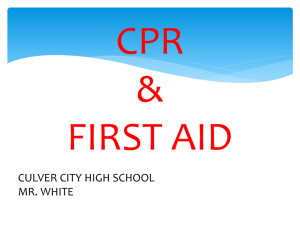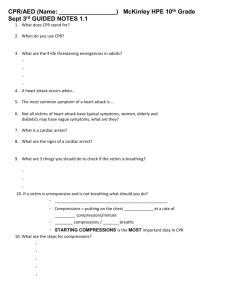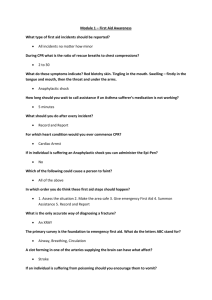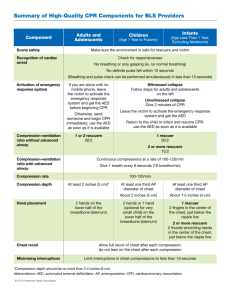ACLS INSTRUCTOR COURSE
advertisement
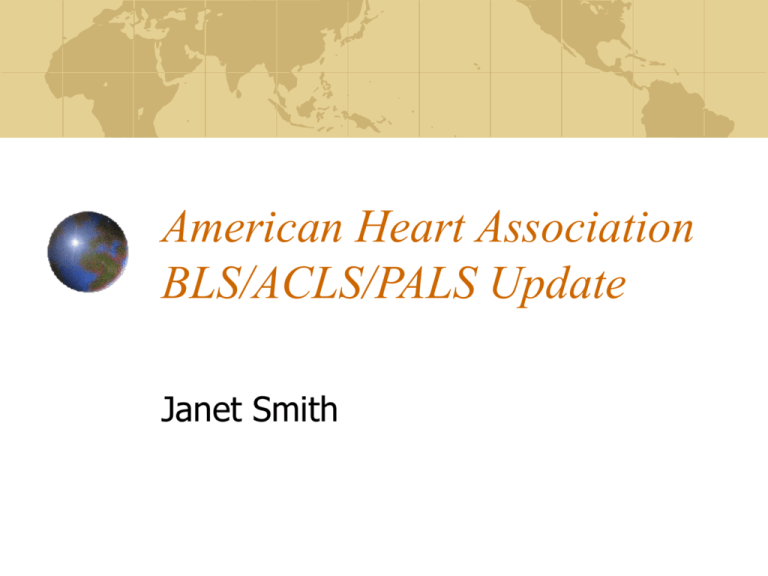
American Heart Association BLS/ACLS/PALS Update Janet Smith Forget everything you know Instructor Goals Incorporate the previous changes from 2001 & present 2005 revisions Less number of algorithms Review Acute Pulmonary Edema, Hypotension, & Shock combined algorithms, & Hypothermia algorithm Stroke algorithm less busy & ACS not much change February 24, 2006 - Rollout First session BLS changes Second session ACLS & PALS update Begin new test – revised 2005 Handbook of Emergency Cardiovascular Care – includes Guidelines CPR/ECC 2005. Nice addition cardiac markers, Treatment w/ Non-ST-segment Elevation MI Instructor Objectives Fit the course to your needs Adult learners need positive reinforcement & deal well with scenarios Understand the exam (new & improved) What is your environment Student Objectives Discuss new basic life support guidelines Discuss patient assessment & survey Discuss the use of ACLS drugs Stations: Determine competency Discuss the ethical considerations in resuscitation What type of course do you need? Recertification versus full course Utilize your study guides or “cheat sheets” Review pretest written exam Provide scenarios ACLS goals Emphasis on trained & equipped Health Care Professional (HCP), but only in conjunction with trained lay rescuer & reduce time to CPR and shock delivery & obtain ultimate success Effective ACLS begins with high-quality CPR Drug changes 2005 Most drug doses are the same as those recommended in 2000 – except use Atropine 0.5 mg IV for Bradycardia. May repeat to a total of 3 mg. Epinephrine or dopamine may be administered while waiting for a pacemaker Early intervention & effective CPR 5 major changes 2005 guidelines Emphasis on, & recommendations to improve, delivery of effective chest compressions A single compression-to-ventilation ratio for all single rescuers for all victims (except newborns) 5 major changes 2005 guidelines Recommendation that each rescue breath be given over 1 second & should produce visible chest rise A new recommendation that single shock, followed by immediate CPR, be used to attempt defibrillation for VF cardiac arrest. Rhythm checks should be performed every 2 minutes 5 major changes 2005 guidelines Endorsement of the 2003 ILCOR recommendations for use of AEDs in children 1 to 8 years old (and older); use a child dose-reduction system if available 5 major changes continued: AED – teaching point Some AED’s have shown to be very accurate in recognizing pediatric shockable rhythms & may be used with regular adult pads Age Definition “Child” CPR guidelines apply to victims 1 year to the onset of puberty (about 12 – 14 years old) Chest compressions are recommended if the heart rate is less than 60 per minute with signs of poor perfusion Effective chest compressions “push hard & push fast” & chest compress the chest @ a rate of about 100 per minute (except newborns) Use 1 or 2 hands with a child (Use technique that gives best results) Allow the chest to recoil Limit interruptions in chest compression Effective chest compressions Chest compressions create a small amount of blood flow to vital organs – the better the chest compressions (adequate rate, depth, & allowing for recoil) the more blood flow is produced Arterial and central venous pressure waveforms during external closed chest compression Idris, A. H. et al. Circulation 1996;94:2324-2336 Copyright ©1996 American Heart Association Universal Compression-toVentilation – all lone rescuers One universal compression-toventilation ratio for all lone rescuers: Single compression to ventilation ration of 30:2 for single rescuers of victims of all ages Teaching point: Simplify CPR & increase blood flow to the heart 1-Second breaths during all CPR All breaths should be given over 1 second w/ significant volume to achieve visible chest rise Teaching point: During CPR, blood flow to the lungs is much less than normal, so the victim needs less ventilation than normal Review of BLS guidelines Determine if you require BLS proof prior to your course Basic Life Support – Teaching concepts Early bystander CPR can double or triple the victim’s survival from VF & Sudden cardiac arrest (SCA) CPR plus defibrillator within 3 – 5 minutes of collapse can produce survival rates as high as 49% to 75% Basic Life Support – Calling for help Lone Healthcare provider: Sudden collapse – Phone 911 & get an AED available & then return to victim to begin CPR Unresponsive victim w/ likely drowning – deliver about 5 cycles (about 2 minutes) of CPR prior to phoning 911 to get the AED & then return to CPR Lone Healthcare Provider/CPR Scenario: Patient unresponsive & nonbreathing the Lone Healthcare provider will give 2 rescue breaths & then feel a pulse for no more than 10 seconds. If no pulse – begin compression Adult: 30:2 Child: 15:2 (two rescuers) HCP- Rescue breathing Deliver rescue breath over 1 second Rescue breathing for a victim w/pulse Adult: 10 to 12 breaths/minute Infant/child: 12 to 20 breaths/minute Teaching point: Less ventilation than normal & not as effective as compressions Chest compressions – components Adult: Center chest & @ nipple line & 1 ½ to 2 inches using heel of both hands & lower half of sternum Child: 1/3 to ½ depth of chest & using heel of one hand Rate: 100 on all patients HCP Chest compressions Compression during CPR & NO advanced airway is present: Deliver cycles of compressions 30:2 Compression during CPR & advanced airway IS present: No longer use cycles or pausing for rescue breathing. Deliver 100 compressions/minute w/ 810 breaths/minute Lay Rescuers CPR – may include information with your course Lay rescuers should immediately begin cycles of chest compressions after delivering 2 rescue breaths in the unresponsive victim. Lay rescuers are not taught to assess for pulse or sings or circulation Research notes that the lay public has a difficult time locating the correct place for palpation Defibrillation One shock followed by immediate CPR beginning w/ chest compressions & 5 cycles or 2 minutes Monophasic: 360 J Biphasic: 150 to 200 J AED Review Use the model for teaching & state the proper order 4-Universal steps: Power AED Attach to victim Analyze rhythm Deliver shock if indicated Use of the AED Use adult pads on adults Use AED after 5 cycles of CPR (out of hospital) No recommendation for infants < 1 year of age Children 1 to 8 Use an AED with pediatric dose-attenuator Electrical Therapies Defibrillation involves delivery of current through the chest & to the heart to depolarize myocardial cells & eliminate VF Monophasic – Deliver current to one polarity & higher energy level Biphasic – Lower energy & are more in current use Management of Pulseless Arrest 5 cycles or 2 minutes or uninterrupted CPR & should resume immediately after deliver 1 shock Pulse & rhythm are NOT checked after shock Management of cardiac arrest Drug administration is of 2nd importance NO IV access: Lidocaine, epinephrine, atropine, narcan, & vasopression are absorbed via the trachea w/typical dose 2 to 2 ½ times the recommended IV dose & should dilute with water or NS Administer drugs during CPR HCP- Rescue breathing Deliver rescue breath over 1 second Rescue breathing for a victim w/pulse Adult: 10 to 12 breaths/minute Infant/child: 12 to 20 breaths/minute Teaching point: Less ventilation than normal & not as effective as compressions Airway management - review & observe student performance Demonstrate the BVM Intubation techniques Secondary confirmation techniques Securing the ETT C-Spine precautions & trauma 5-point chest exam Airway & C-spine management Use head tilt-chin lift technique to open the airway of trauma victim unless cervical spine injury is suspected Teaching point: Jaw thrust is a difficult maneuver & may not be an effective way to open the airway Airway station – Use BVM Anyone providing prehospital care for adult, children, or infants should be trained to deliver effective oxygenation & ventilation The use of BVM should be considered to be the primary method of venilatory support, especially if transport times are short Airway Management – Issues to discuss during the station: BVM can be as effective as ETT A study noted 25% intubations were found to have esophageal/pharyngeal tube placement Secondary confirmation involves the use of end-tidal CO2 detectors Review tube holder & LMA Verify correct ETT placement To reduce the risk of esophageal misplacement or displacement – Confirm the placement immediately after insertion, in the transport vehicle, & whenever the patient is moved Acute Coronary Syndromes - goals Reduce the amount of myocardial necrosis & preserve LV function Prevent Major adverse cardiac events “MACE” Review new ACS algorithm Acute Coronary Syndromes M – O – N – A = Same Rx Each minute the patient is in VF has 10% decrease of chance of survival EMS: Monitor, support ABCs, CPR, & defibrillation Goal: Door-balloon 90 minutes & Doorneedle 30 minutes Stroke Intravenous tPA who meet (NINDS) is administered by physicians w/ defined protocol, knowledgeable team, & institutional commitment Stroke patients should be admitted to Stroke Units Acute Ischemic Stroke Lower blood sugar (> 200mg/dL) Orders urgent CT Scan < 25 minutes Reads CT scan < 45 minutes If scan shows ICH/SAH call Neurosurgery If no hemorrhage, continues protocol Symptom onset > 3 hours? Algorithm Review Treatment of Wide Complex Tachycardias ACLS providers should make a reasonable attempt to distinguish hemodynamically stable VT from SVT with aberrancy. History of CAD suggest ventricular origin. Obtain a 12-lead (when possible) & note the QRS yet accuracy requires experience Tachycardia with Pulses Treatment summarized in a single algorithm – Immediate synchronized cardioversion for unstable patient Narrow versus Wide Complex – Control rate (Diltiazem review) Treat contributing factors Unstable Tachycardia/Cardioversion Primary & Secondary ABCs D = Determine Defibrillation Determine Sedatives & Analgesics Know rapid infusion of antiarrhythmic agents Post cardioversion care Change unsynchronized mode Pulseless Arrest VF/VT 5 cycles of CPR prior to defibrillation & minimize interruptions Deliver 1 shock (120 or 200j) & resume CPR immediately Epinephrine 1mg or vasopressin 40 U IV/IO to replace 1st dose of Epinephrine May shock either 200j (unknown biphasic device) or 360j Asystole/PEA Attach monitor/defibrillator Shockable Epinephrine & Vasopressin Consider Atropine 1 mg IV/IO for asystole or slow PEA rate Asystole Advanced airway control Establish IV – Epinephrine & Atropine Consider TCP (start @ once) Consider differential diagnosis Look for specific causes – The H’s & T’s with new addition Pulseless Electrical Activity Primary & Secondary Airway control IV access – Epinephrine 1 mg IVP Atropine 1 mg IVP (if rate is slow) 6 H’s & 5 T’s Act upon differential diagnosis when reasonable Correct contributing factors Hypovolemia Hypoxia Hydrogen Hypo/Hyperkalemia Hypoglycemia Hypothermia Toxins Tamponade Tension pneumo Thrombosis (coronary or pulmonary) Trauma Bradycardia Prepare TCP without delay Recognize 2nd & 3rd Degree Blocks Atropine 0.5 mg IV while waiting TCP (total dose 3mg) Epinephrine 2 to 10 mcg/min or Dopamine infusion 2 to 10 mcg Search contributing factors Medication Review Anti-arrhythmic agents Lidocaine – Alternative to Amiodarone Adenosine – Slow AV nodal conduction Procainamide – Supraventricular arrhythmias & VT 20 mg/min total 17mg/kg Amiodarone – Is effective with SVT because it alters conduction through the accessory pathway Dobutamine Indication – Pump problems (CHF, Pulmonary congestion) SBP 70 to 100 mm Hg & no signs of shock Precautions – May cause tachyarrhythmias, fluctuations in blood pressure, headache, & nausea 2 to 20 mcg/kg/minute Dopamine Second-line drug for symptomatic bradycardia (after atropine) Use for hypotension SBP , 70 to 100 mm Hg) with signs & symptoms of shock Correct hypovolemia with volume replacement 2 to 20 mcg/kg/minute Amiodarone Recurrent VF & recurrent hemodynamically unstable VT Requires several time consuming steps for administration (Glass ampule, etc) Cardiac arrest: 300 mg IV initial dose & ONE 150 mg IVP in 3-5 minutes Recurrent Ventricular arrhythmias: 150 mg IV over 10 minutes Magnesium Use in cardiac arrest only if Torsades de Pointes is suspected or Hypomagnesaemia is present Life-threatening digitalis toxicity 1-2 g over 5 -20 min Diltiazem Indications: To control ventricular rate in atrial fibrillation & atrial flutter Rate control: 15 to 20 mg (0.25 mg/kg) IV over 2 minutes Caution: Avoid in patient receiving or Beta blockers, B/P may drop due to peripheral vasodilation Epinephrine Cardiac arrest: VF, Pulseless VT, Asystole, PEA Symptomatic bradycardia: after atropine & an alternative infusion to dopamine Dose: IV/IO 1 mg (10 mL of 1:10,000) every 3-5 minutes Vasopressin Indications: Alternative pressor to epinephrine in treatment of adult shockrefractory VF Dose: 40 U IV/IO push may replace either first or second dose of epinephrine Fibinolytic Agents (Activase, tPA) Indications: For AMI in Adults – ST elevation ( > 1 mm in 2 leads) or new LBB, in context of S & S of AMI, Time of onset of symptoms < 12 hours Indications: For Acute Ischemic Stroke Focal neurologic deficits, Absence of Intracerbral or SAH on CT, & nonimproving symptoms < 3 hours onset “Flat Line Protocol” The sensitivity or “gain” displayed on the monitor is one of the important things to check or confirm true asystole. Check the POWER (on/off) Battery supply & lead select (if set to paddles) Postresuscitation support Vasoactive support Induced hypothermia cooled to 32 to 34C for 12 to 24 hours after ROSC Ace Inhibitors: Reduces mortality & CHF with AMI (Angiotensin or ACE is a chemical that causes the heart to contract such as Vasotec) Ethical Considerations Do not resuscitate Family presence – Let the family view all of your care & include in decision making if possible Family & staff grief counseling CISD assistance The written exam Review EID & hypopharyngeal intubation (esophageal) Hypovolemia easy to treat Prehospital asystole = drug overdose Non-contrast CT Review Retavase & Heparin CVA v insulin-induced hypoglycemia The written exam Cannot be open book or use of notes Be prepared to deal with the student that challenges the exam or the answers How do you deal with the student who fails the exam? What can you expect in the course Decreased lectures More “hands on” Role-play Scenario review Group involvement Questions?
